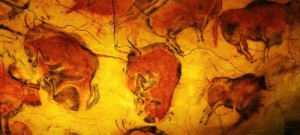Part of my recent trip to Europe was a scholar-led tour of Late Paleolithic cave art, starting in the Vézère river valley of France’s Dordogne and working west to northern Spain’s Cantabria region. I’m no expert on the era — just an armchair history geek with a lifelong early art fascination. I could bore you to tears with my holiday pics, but since this is theoretically a guitar/music blog, I’ll keep things brief and music-focused.

This sculpture of an early hominid from the Museum of Human Evolution in Burgos, Spain, has nothing to do with the fully modern homo sapiens who decorated the caves. Furthermore, recent research calls into question the historical accuracy for her guitar. Some scholars even suspect that it may have been Photoshopped into this photo.
Basically, I got to visit many of the best cave art sites not closed to the public, as both Lascaux and Altimira have been for many years. By sheer coincidence, one fellow geek was Hollywood composer Craig Safan, perhaps best known as the composer for Cheers. In addition to being a cool, smart, and fun guy, Craig has been obsessed with these caves since he visited them decades ago as a young man, and is planning a major composition inspired by them. Unlike me, he was up to date on all the latest research about music and musical instruments of the era, mostly based on fragments of simple flutes, bull roarers, and such.
Craig was traveling with a tiny Zoom recorder, a little ocarina, and a pair of small resonant stones. As we’d tour various cave sites as Font de Gaume, Pech Merle, El Castillo, and Isturitz, he discretely record little clacks, whistles, and tongue clicks, cave ambience and all.
Now, the last thing I’d planned for this vacation was an impulse response reverb experiment, especially after having recently written about the technology in this blog and for Premier Guitar. But it occurred to me that we might be able to capture the ambience as impulse responses in order to reproduce it later in the studio. I didn’t have a proper device for playing back a test tone, though I might have tried it on a phone or iPad. But Craig’s clacks and clicks seemed like they might work. He sent me a few audio files after we both got back to California. With a little editing and EQing, they worked pretty well — have a listen below, and help yourself to a couple of reverb files if you like. Some of the nicest are from the deepest gallery of Pech Merle.
![The earliest known musical instruments are flutes.Some may be as much as 43,000 years old. [Museo de Altamira.]](https://tonefiend.com/wp-content/uploads/DSC01453-300x200.jpg)
The earliest known musical instruments are flutes.Some may be as much as 43,000 years old. [Museo de Altamira.]
I think there’s little doubt that our Ice Age ancestors created willful, organized sound in the caves, but I’m cautious about tossing around the culturally loaded term “music” (and, for that matter, “art”). It’s impossible to know what those sounds and images meant to their creators, though it sure if fun to follow the violent academic debates about such things from the sidelines. One theory after another has bitten the dust over the last century or so. No, it wasn’t art for art’s sake, pretty much everyone agrees nowadays. No, the images of bison and horses weren’t hunting magic — the animals painted just don’t correlate to the animals eaten. The hot theory today, promoted by French prehistorian Jean Clottes, is that cave art had shamanistic origins. (A great English language book on the topic is The Mind in the Cave: Consciousness and the Origins of Art by David Lewis-Williams, where the author makes a compelling case that our impulses toward “art” and religion are strongly related to the way in which our brains evolved, and the properties that differentiated homo sapiens from earlier species, notably Neanderthal, who cohabited Europe with cave-painting homo sapiens until the died out around 24,000 years ago.)
Just how much we differ from Neanderthal may be the most heated topic in an extremely heated field of study. Until just a couple of years ago, the prevailing opinion was that Neanderthal was a separate species who were displaced/killed by Homo Sapiens with little interbreeding. But now that we’ve mapped both the Homo Sapiens and Neanderthal genomes, we know that a) Homo Sapiens and Neanderthal interbred extensivly, b) almost all living humans except Africans have Neanderthal genes, and c) Neanderthals aren’t even a separate species, since the defining trait of a common species is the ability to breed and produce fertile offspring. There were more like a separate race.

The famous bison ceiling from Altamira. “After Altamira,” wrote Picasso, “all is decadence.”
But how close to us were the Neanderthals? Depends who you ask. There’s no evidence yet that they produced paintings, artifacts, or musical instruments. Some believe that remains from Neanderthal burials prove a notion of the afterlife, and hence, the sort of symbolic thinking that defines human consciousness. But our dedicated tour scholar, Dr. Harold Dibble of the University of Pennsylvania, has studied Neanderthal sites around the world for decades, and he’s a skeptic who has disputed the fact that there ever were Neanderthal burials. But he’s swimming against the tide of current European thought, where many scholars argue that they were fewer differences between Sapiens and Neanderthal than previously believed, and that there’s no reason to believe they didn’t have a capacity for symbolic thought. Harold, by the way, is a drummer, and the best kind too: one who hasn’t heard all the best drummer jokes. I’m pleased to report that he is not just a fine scholar, but a good sport.
I’m agnostic on these Neanderthal issues — I just don’t know enough. But my reaction to visiting the caves mirrors that of thousands of others: Dumbstruck by the beauty and imagination of the earliest known images. It’s evident that the minds of our Ice Age ancestors were every bit as complex and capable as ours. We just have more stuff.
Here’s how the reverb sounded back in San Francisco, after I’d loaded it into Logic’s Space Designer plug-in:
Here’s a link to download the IR files. You should be able to drop them into any impulse response plug-in to get similar results.
Another example, this one made with electric guitar, a looper, and the IR file loaded into a Logidy EPSi pedal:








Nice post. Only you would visit these caves and think that they should be imported into the Space Designer Reverb program!
“But how close to use were the Neanderthals?” I believe there is a typo that gives the sentence a different twist from what was originally intended.
I want to see all the vacation pics ! Sounds like you had a good time.
I am glad you enjoyed your trip. It seems that you were quite close to my area.
Sounds like a pretty awesome trip! I’ve wanted to check those caves out for years, but especially after seeing Cave of Forgotten Dreams, the Werner Herzog doc. Incidentally, the soundtrack (and mini doc in the DVD extras) is sublime and beautiful.
My kids and I once toured the “Bluff Dwellers’ Cave” in soutwest Missouri while on a canoeing trip. The teenage tour guide had actually worked out a couple of simple tunes on stalactites, but wouldn’t let us try! My kids were pissed. ;D